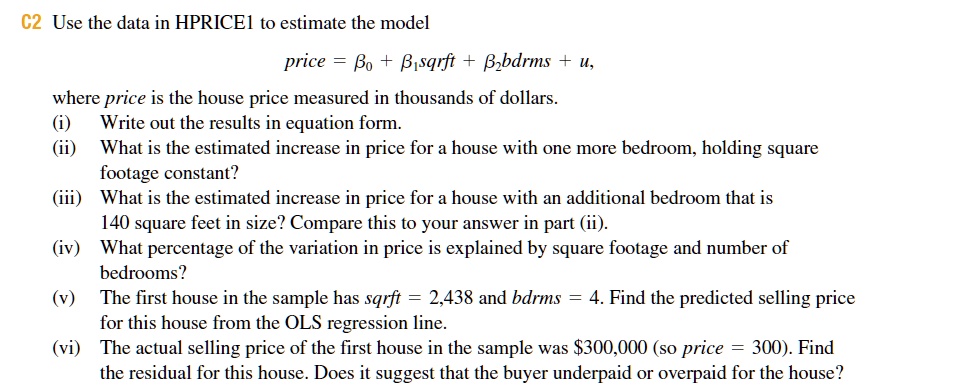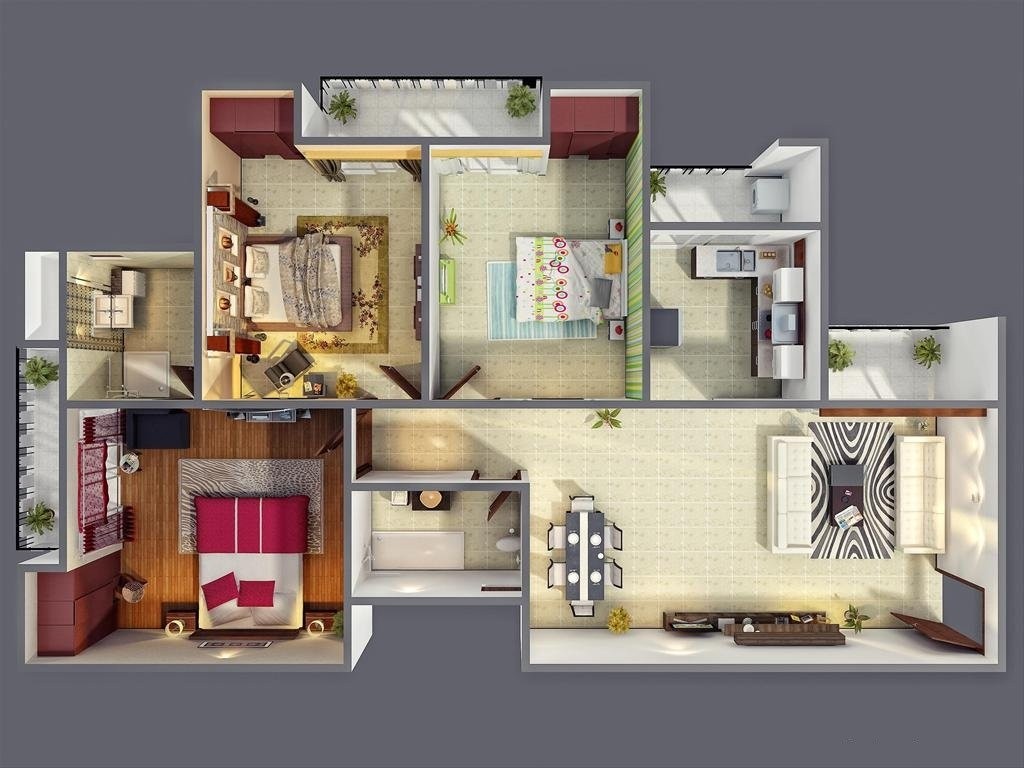Understanding Square Footage in 3-Bedroom Houses

Square footage is a crucial factor in determining the size and value of a 3-bedroom house. It represents the total living area of the house, measured in square feet, and provides a standardized way to compare different properties. Understanding square footage helps potential buyers evaluate the space available, estimate potential costs, and make informed decisions.
Square Footage Ranges for 3-Bedroom Houses
The square footage of 3-bedroom houses varies significantly depending on the location, housing market, and architectural style.
- In urban areas with high property values, 3-bedroom houses may range from 1,500 to 2,500 square feet or more. These houses often feature smaller lot sizes and prioritize efficient use of space.
- In suburban areas, 3-bedroom houses typically range from 1,800 to 2,800 square feet. These homes often have larger yards and more spacious interiors.
- In rural areas, 3-bedroom houses can range from 1,500 to 3,000 square feet or more. These homes may have larger lots and offer more privacy.
Average Square Footage of 3-Bedroom Houses in Different Architectural Styles, 3 bedroom house square footage
The average square footage of 3-bedroom houses can vary significantly depending on the architectural style.
- Ranch Style: Ranch houses are typically single-story homes with a simple, rectangular design. They often have open floor plans and are known for their practicality and affordability. Average square footage for a 3-bedroom ranch house is around 1,500 to 2,000 square feet.
- Colonial Style: Colonial houses are characterized by their symmetrical facades, two or three stories, and traditional features like columns and gables. They offer a classic and elegant aesthetic. The average square footage for a 3-bedroom colonial house is typically around 2,000 to 2,500 square feet.
- Modern Style: Modern houses are known for their clean lines, open floor plans, and use of natural light. They often feature large windows, flat roofs, and minimalist interiors. The average square footage for a 3-bedroom modern house can range from 1,800 to 2,500 square feet, depending on the specific design.
Factors Influencing Square Footage in 3-Bedroom Houses

The square footage of a 3-bedroom house is influenced by a variety of factors, including the size of the lot, the number of bathrooms, and the presence of additional features like a basement or garage. These factors can significantly impact the overall living space and, consequently, the value of the property.
Impact of Lot Size, Number of Bathrooms, and Basement/Garage Space
The size of the lot on which a house is built directly affects the potential square footage of the dwelling. Larger lots typically allow for larger homes, while smaller lots may limit the size of the house. The number of bathrooms is another significant factor, as each bathroom adds to the overall square footage. Basements and garages, if included in the home, also contribute to the total square footage. However, it is important to note that finished basements and garages are typically included in the calculated square footage, while unfinished areas may not be.
Impact of Additional Features
Additional features, such as finished basements, sunrooms, and decks, can also significantly impact the overall square footage of a 3-bedroom house. Finished basements can provide valuable living space, adding square footage for bedrooms, recreation rooms, or home offices. Sunrooms, which are often used as extensions of the living space, also contribute to the total square footage. Decks, while not typically included in the calculated square footage, can add significant outdoor living space and enhance the overall value of the property.
Typical Square Footage Breakdown for Rooms in a 3-Bedroom House
The following table provides a typical breakdown of square footage for different rooms in a 3-bedroom house. It is important to note that these are just estimates, and actual square footage may vary depending on the specific design and features of the house.
| Room | Typical Square Footage |
| ————– | ——————— |
| Living Room | 200-400 sq ft |
| Kitchen | 150-250 sq ft |
| Dining Room | 100-200 sq ft |
| Master Bedroom | 150-250 sq ft |
| Other Bedrooms | 100-150 sq ft |
| Bathrooms | 50-100 sq ft each |
| Hallways | 50-100 sq ft |
| Total | 1000-1800 sq ft |
Using Square Footage to Evaluate 3-Bedroom Houses: 3 Bedroom House Square Footage

Square footage is a crucial factor in assessing the functionality and livability of a 3-bedroom house. It provides a quantitative measure of the usable space available, which can be used to compare different properties and determine if a home meets your specific needs and preferences.
Understanding the square footage of a 3-bedroom house allows you to envision how the space will be utilized, how furniture will be arranged, and how the flow of traffic will move throughout the home.
Understanding Square Footage Distribution
The square footage of a 3-bedroom house is not simply a single number. It’s important to understand how the square footage is distributed across different areas of the home. For instance, a 1,500 square foot house might have a spacious living room and kitchen, but smaller bedrooms, while another 1,500 square foot house might have larger bedrooms but a more compact living area.
Consider the following aspects of square footage distribution when evaluating a 3-bedroom house:
- Living Areas: The square footage of the living room, dining room, and family room should be sufficient for your needs and entertaining style. A larger living area allows for more furniture, a larger gathering space, and greater flexibility in arranging the space.
- Bedrooms: The square footage of the bedrooms should be adequate for your furniture and personal belongings. Larger bedrooms can accommodate king-sized beds, dressers, and additional seating, while smaller bedrooms might be more suitable for single occupants or those with minimal furniture.
- Kitchen and Bathrooms: The square footage of the kitchen and bathrooms should be functional and comfortable. A larger kitchen allows for more counter space, storage, and appliances, while a larger bathroom might offer more space for a walk-in shower or a separate bathtub and shower.
- Other Areas: Consider the square footage allocated to other areas such as hallways, closets, laundry rooms, and storage spaces. These areas contribute to the overall functionality and livability of the home.
Evaluating Square Footage for Functionality
To effectively evaluate the square footage of a 3-bedroom house, consider the following questions:
- How does the square footage of each room align with your lifestyle and needs? Do you need a spacious living room for entertaining, or a larger kitchen for cooking and baking? Are you looking for large bedrooms with ample storage space, or smaller bedrooms that are more efficient?
- Does the overall square footage of the house provide sufficient space for your family and belongings? Consider the number of people living in the house, the amount of furniture and belongings you need to store, and the frequency of guests you entertain.
- Is the square footage distributed in a way that optimizes functionality and flow? Consider the layout of the house and how easily you can move between different rooms. A well-designed layout will maximize the use of space and create a comfortable and efficient living environment.
- Does the square footage meet local building codes and regulations? This is important for ensuring that the house is safe and meets the minimum requirements for habitability.
Assessing Square Footage for Livability
The square footage of a 3-bedroom house also plays a significant role in its livability. Consider the following factors when evaluating the square footage for livability:
- Natural Light: The amount of natural light entering the house is influenced by the size and placement of windows. Larger windows allow for more natural light, which can create a brighter and more inviting atmosphere.
- Air Circulation: The square footage of a house can affect air circulation. A well-ventilated house with adequate square footage allows for fresh air to circulate throughout the home, creating a healthier and more comfortable living environment.
- Storage Space: The square footage of closets, pantries, and storage areas should be sufficient for your belongings. Adequate storage space can help to keep the house organized and clutter-free.
- Outdoor Space: The square footage of the yard or patio can provide additional living space for entertaining, gardening, or simply enjoying the outdoors. Consider the size of the outdoor space and how it aligns with your lifestyle and preferences.
3 bedroom house square footage – Figuring out the square footage of a 3 bedroom house is a crucial step in planning your dream home. You’ll want enough space for all your belongings and maybe even a cozy nook for a comfy reading chair. And while you’re planning, don’t forget to add a personal touch to your bathroom with rustic bathroom wood signs that’ll make it feel like a spa retreat.
Once you’ve got the square footage sorted and your bathroom looking fabulous, you’ll be one step closer to making your dream home a reality!
Figuring out the square footage of a 3-bedroom house is super important, especially when you’re planning your dream bathroom. A spacious bathroom is a must, and you can really elevate the vibe with some stylish natural wood bathroom storage.
It adds a touch of warmth and practicality, and you can organize all your toiletries like a pro. Once you’ve got the bathroom sorted, you can really focus on the rest of the house, like finding the perfect spot for that awesome gaming setup!